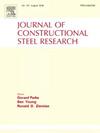Innovative dissipative pin-devices for seismic-resilient composite steel-concrete buildings: Experimental and numerical investigation
IF 4
2区 工程技术
Q1 CONSTRUCTION & BUILDING TECHNOLOGY
引用次数: 0
Abstract
The DISSIPABLE pilot/demonstration project [1] aimed to promote buildings with low-cost, dissipative, and easily replaceable energy-dissipation devices, enhancing economic efficiency and long-term post-seismic resilience. These devices allow for the preservation of primary structural components, avoiding replacement or demolition after high-magnitude seismic events, thus improving sustainability by reducing material, time, and equipment compared to conventional braced-frame systems. This paper introduces the Dissipative Replaceable Bracing Connection (DRBrC), which utilizes a steel pin as a fuse to absorb seismic energy. The DRBrC connects the bracing to the column via a dissipative device, which can be easily replaced after a seismic event. The device consists of two internal eye-bar plates welded to a plate, forming a T-joint, with a similar endplate welded to the diagonal brace. These components are bolted together, enabling the replacement of the dissipative pin. The column connection also features external eye-bar plates. Following a seismic event, the pin device can be replaced, while the primary structural elements are preserved for reuse. The paper details the design of this innovative hysteretic dissipative pin device, presents experimental results of 28 different devices under low-cycle fatigue, compares the different solutions tested and, finally, presents numerical simulations to evaluate the performance of one of the devices.
求助全文
约1分钟内获得全文
求助全文
来源期刊

Journal of Constructional Steel Research
工程技术-工程:土木
CiteScore
7.90
自引率
19.50%
发文量
550
审稿时长
46 days
期刊介绍:
The Journal of Constructional Steel Research provides an international forum for the presentation and discussion of the latest developments in structural steel research and their applications. It is aimed not only at researchers but also at those likely to be most affected by research results, i.e. designers and fabricators. Original papers of a high standard dealing with all aspects of steel research including theoretical and experimental research on elements, assemblages, connection and material properties are considered for publication.
 求助内容:
求助内容: 应助结果提醒方式:
应助结果提醒方式:


